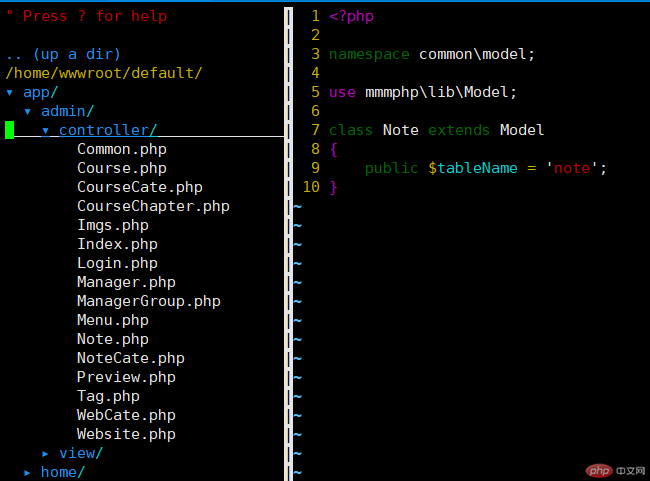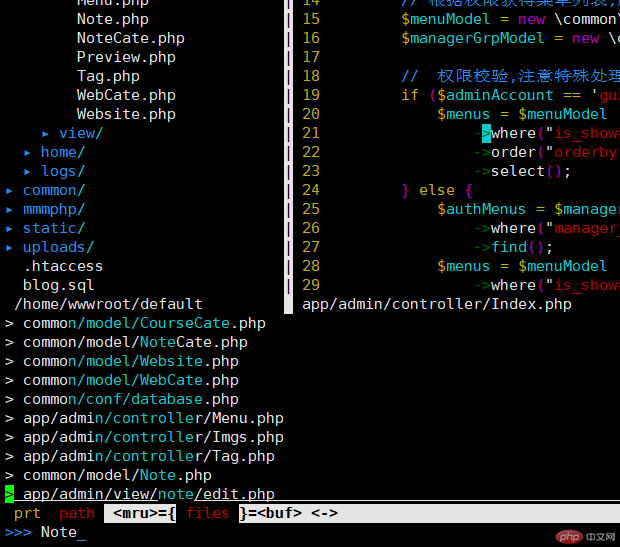 Operation and Maintenance
Operation and Maintenance
 Linux Operation and Maintenance
Linux Operation and Maintenance
 VIM directory tree plug-in and file search plug-in
VIM directory tree plug-in and file search plug-in
VIM directory tree plug-in and file search plug-in
Today I will introduce to you two essential VIM plug-ins for development, directory tree and quick file search plug-ins. People who use them say they are good, but I won’t tell most people. O(∩_∩)Ohaha~
Nerd tree
We know that vim has directory file management by default. For development For a slightly larger project, it would be very inconvenient. But with the NerdTree plug-in, this need can be met.
Github address: https://github.com/scrooloose/nerdtree
After installation, open the vim editor. By default, no directory tree appears on the left side. You need to type NERDTreeToggle on the command line. Then a directory tree will appear on the left.
This is still a bit inconvenient. We need to add a few lines to the configuration file.vimrc. Use mapping to facilitate our operations.
nnoremap <leader>v :NERDTreeFind<CR> nnoremap <leader>g :NERDTreeToggle<CR> let NERDTreeShowHidden=1 let NERDTreeIgnore = ['\.pyc','\~$','\.swp', '\.git']
NERDTreeFind means to find the location of the directory tree where the current file is located.
NERDTreeToggle indicates switching the display of the directory tree
NERDTreeShowHidden indicates whether to display hidden files
NERDTreeIgnore Indicates which files are not displayed
In the directory tree, use the key j to move files down and the k key to move files up. For folders, the enter key switches the folder open and closed, and for files, it opens the file.

ctrlp
With the file directory tree, it is indeed much more convenient to develop projects. But there is still a problem that has not been solved. If the directory level is relatively deep, it will be very troublesome to find them one by one every time. Is there any good solution? Yes, you can use the ctrlp plug-in.
ctrlp is a plug-in that quickly finds files and opens them. It is also very powerful. It supports fuzzy search and is very fast.
ctrlp’s github address is: https://github.com/kien/ctrlp.vim. We use vim-plug to install it. After installation is complete, then set its shortcut keys.
let g:ctrlp_map = '<c-p>'
After installing and configuring it, let’s see how it is used. Open the vim editor, press ctrl p, and enter the file you want to open.

You can see that all matching files are displayed. Then, move the matching files up and down via ctrl j and ctrl k.
Let me introduce you to a little trick to quickly locate the directory tree where the file is located.
First find the file you want to open through ctrl p
Locate the file
Enter
v to quickly locate the directory location where the file is located.
The above is the detailed content of VIM directory tree plug-in and file search plug-in. For more information, please follow other related articles on the PHP Chinese website!

Hot AI Tools

Undresser.AI Undress
AI-powered app for creating realistic nude photos

AI Clothes Remover
Online AI tool for removing clothes from photos.

Undress AI Tool
Undress images for free

Clothoff.io
AI clothes remover

Video Face Swap
Swap faces in any video effortlessly with our completely free AI face swap tool!

Hot Article

Hot Tools

Notepad++7.3.1
Easy-to-use and free code editor

SublimeText3 Chinese version
Chinese version, very easy to use

Zend Studio 13.0.1
Powerful PHP integrated development environment

Dreamweaver CS6
Visual web development tools

SublimeText3 Mac version
God-level code editing software (SublimeText3)

Hot Topics
 1677
1677
 14
14
 1431
1431
 52
52
 1334
1334
 25
25
 1280
1280
 29
29
 1257
1257
 24
24
 Linux Architecture: Unveiling the 5 Basic Components
Apr 20, 2025 am 12:04 AM
Linux Architecture: Unveiling the 5 Basic Components
Apr 20, 2025 am 12:04 AM
The five basic components of the Linux system are: 1. Kernel, 2. System library, 3. System utilities, 4. Graphical user interface, 5. Applications. The kernel manages hardware resources, the system library provides precompiled functions, system utilities are used for system management, the GUI provides visual interaction, and applications use these components to implement functions.
 How to check the warehouse address of git
Apr 17, 2025 pm 01:54 PM
How to check the warehouse address of git
Apr 17, 2025 pm 01:54 PM
To view the Git repository address, perform the following steps: 1. Open the command line and navigate to the repository directory; 2. Run the "git remote -v" command; 3. View the repository name in the output and its corresponding address.
 How to run java code in notepad
Apr 16, 2025 pm 07:39 PM
How to run java code in notepad
Apr 16, 2025 pm 07:39 PM
Although Notepad cannot run Java code directly, it can be achieved by using other tools: using the command line compiler (javac) to generate a bytecode file (filename.class). Use the Java interpreter (java) to interpret bytecode, execute the code, and output the result.
 How to run sublime after writing the code
Apr 16, 2025 am 08:51 AM
How to run sublime after writing the code
Apr 16, 2025 am 08:51 AM
There are six ways to run code in Sublime: through hotkeys, menus, build systems, command lines, set default build systems, and custom build commands, and run individual files/projects by right-clicking on projects/files. The build system availability depends on the installation of Sublime Text.
 What is the main purpose of Linux?
Apr 16, 2025 am 12:19 AM
What is the main purpose of Linux?
Apr 16, 2025 am 12:19 AM
The main uses of Linux include: 1. Server operating system, 2. Embedded system, 3. Desktop operating system, 4. Development and testing environment. Linux excels in these areas, providing stability, security and efficient development tools.
 git software installation
Apr 17, 2025 am 11:57 AM
git software installation
Apr 17, 2025 am 11:57 AM
Installing Git software includes the following steps: Download the installation package and run the installation package to verify the installation configuration Git installation Git Bash (Windows only)
 laravel installation code
Apr 18, 2025 pm 12:30 PM
laravel installation code
Apr 18, 2025 pm 12:30 PM
To install Laravel, follow these steps in sequence: Install Composer (for macOS/Linux and Windows) Install Laravel Installer Create a new project Start Service Access Application (URL: http://127.0.0.1:8000) Set up the database connection (if required)
 How to set important Git configuration global properties
Apr 17, 2025 pm 12:21 PM
How to set important Git configuration global properties
Apr 17, 2025 pm 12:21 PM
There are many ways to customize a development environment, but the global Git configuration file is one that is most likely to be used for custom settings such as usernames, emails, preferred text editors, and remote branches. Here are the key things you need to know about global Git configuration files.



